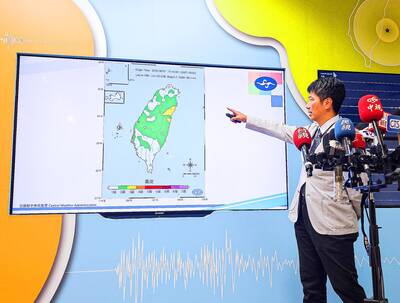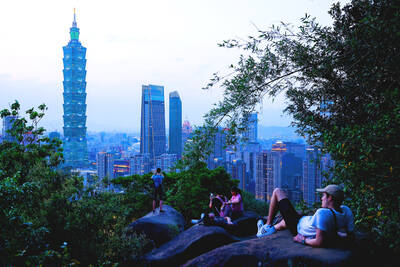A common bottlenose dolphin was found dead on a beach at Guihou Harbor (龜吼) in New Taipei City’s Wanli District (萬里) in the early hours of Wednesday, the latest incident in what is believed to be an unusual spike of stranded dolphins and whales in the aftermath of recent typhoons.
Taiwan Cetacean Society official Yang Wei-cheng (楊瑋誠) said the overwhelming majority of the strandings were likely to have been the result of sonar emissions, which can frighten many species of cetaceans, which use ultrasound for navigation.
Soon after the discovery of the dead dolphin, Coast Patrol Corps 2-1 and Gui Hou Harbour Safety Inspection Office personnel established a cordon and notified the society to remove the animal, sources said.

Photo: Lin Chia-tung, Taipei Times
On Aug. 29, a dolphin was found dead at Green Bay (翡翠灣), less than 1km from the latest incident.
Since Typhoon Megi made landfall on Sept. 28, there have been 12 strandings of whales or dolphins on Taiwan’s coastlines north of Yilan and Taoyuan, with all the animals being deep-sea species that spend time at depths of 1,000m to 2,000m, Yang said, adding that the preliminary results of an investigation would be published in the middle of next month.
In 2005, between 15 and 20 cetaceans were found dead or dying on beaches in northern Taiwan after Typhoon Haitang, Yang said.
At the time, the society enlisted international experts to assist in its research and based on the large volumes of air found in the dead animals’ organs, it was concluded that they died of decompression sickness following a rapid ascent from deep water.
The scientific consensus on cetacean strandings, based mostly on work by Western scientists in the Atlantic Ocean, blames the phenomenon on military-grade sonar, Yang said.
Prior to their death, the animals were probably subjected to sonar emissions from military sources, became terrified and attempted to flee by making a rapid ascent, resulting in fatal decompression, Yang said.
Because many powerful typhoons have passed near Taiwan without incident, a causal relationship between typhoons and strandings cannot be established, Yang said, adding that naval activities concurrent with Typhoon Megi might have caused the strandings.
The quietness of modern submarines has led to a corresponding increase in the power of sonar equipment used to detect them, and the US Navy has placed sonar devices in the waters near Japan’s Ryukyu Islands and the Philippines — to Taiwan’s north and south — to counter the threat of missile-armed submarines from China, Yang said.
Due to those developments, large-scale cetacean strandings will most likely be repeated, Yang said.

Aftershocks from a magnitude 6.2 earthquake that struck off Yilan County at 3:45pm yesterday could reach a magnitude of 5 to 5.5, the Central Weather Administration (CWA) said. Seismological Center technical officer Chiu Chun-ta (邱俊達) told a news conference that the epicenter of the temblor was more than 100km from Taiwan. Although predicted to measure between magnitude 5 and 5.5, the aftershocks would reach an intensity of 1 on Taiwan’s 7-tier scale, which gauges the actual effect of an earthquake, he said. The earthquake lasted longer in Taipei because the city is in a basin, he said. The quake’s epicenter was about 128.9km east-southeast

GENSLER SURVEY: ‘Economic infrastructure is not enough. A city needs to inspire pride, offer moments of joy and foster a sense of belonging,’ the company said Taipei was named the city with the “highest staying power” in the world by US-based design and architecture firm Gensler. The Taiwanese capital earned the top spot among 65 cities across six continents with 64 percent of Taipei respondents in a survey of 33,000 people saying they wanted to stay in the city. Rounding out the top five were Vietnam’s Ho Chi Minh City (61 percent), Singapore (59 percent), Sydney (58 percent) and Berlin (51 percent). Sixth to 10th place went to Monterrey, Mexico; Munich, Germany; Sao Paulo, Brazil; Vancouver; and Seoul. Cities in the US were ranked separately, with Minneapolis first at

The New Taipei City Government today warned about the often-overlooked dangers of playing in water, and recommended safe swimming destinations to cool off from the summer heat. The following locations in the city as safe and fun for those looking to enjoy the water: Chienshuiwan (淺水灣), Baishawan (白沙灣), Jhongjiao Bay (中角灣), Fulong Beach Resort (福隆海水浴場) and Sansia District’s (三峽) Dabao River (大豹溪), New Taipei City Tourism and Travel Department Director-General Yang Tsung-min (楊宗珉) said. Outdoor bodies of water have variables outside of human control, such as changing currents, differing elevations and environmental hazards, all of which can lead to accidents, Yang said. Sudden

Tropical Storm Podul has formed over waters north-northeast of Guam and is expected to approach the seas southeast of Taiwan next week, the Central Weather Administration (CWA) said today. The 11th Pacific storm of the year developed at 2am over waters about 2,660km east of Oluanpi (歐鑾鼻), Pingtung County — Taiwan's southernmost tip. It is projected to move westward and could have its most significant impact on Taiwan on Wednesday and Thursday next week, the CWA said. The agency did not rule out the possibility of issuing a sea warning at that time. According to the CWA's latest update, Podul is drifting west-northwest